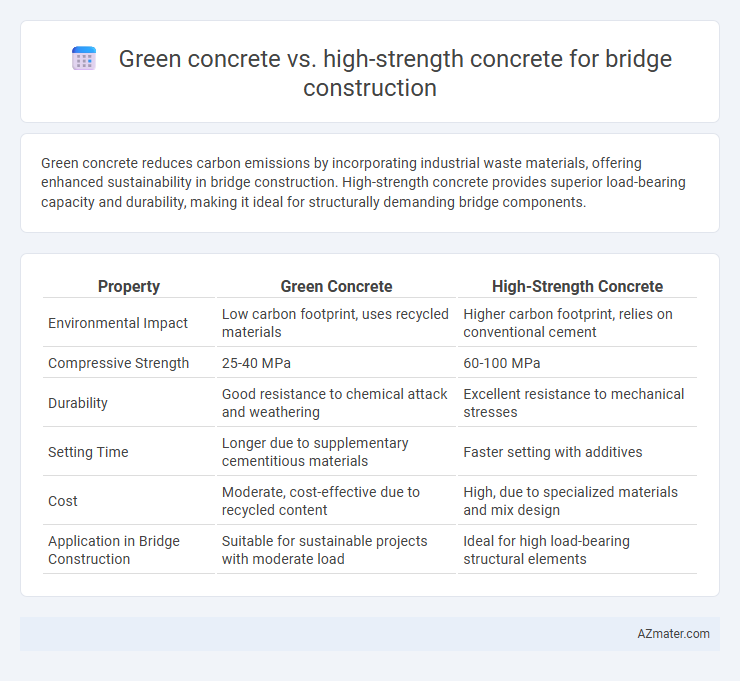Green concrete reduces carbon emissions by incorporating industrial waste materials, offering enhanced sustainability in bridge construction. High-strength concrete provides superior load-bearing capacity and durability, making it ideal for structurally demanding bridge components.
Table of Comparison
| Property | Green Concrete | High-Strength Concrete |
|---|---|---|
| Environmental Impact | Low carbon footprint, uses recycled materials | Higher carbon footprint, relies on conventional cement |
| Compressive Strength | 25-40 MPa | 60-100 MPa |
| Durability | Good resistance to chemical attack and weathering | Excellent resistance to mechanical stresses |
| Setting Time | Longer due to supplementary cementitious materials | Faster setting with additives |
| Cost | Moderate, cost-effective due to recycled content | High, due to specialized materials and mix design |
| Application in Bridge Construction | Suitable for sustainable projects with moderate load | Ideal for high load-bearing structural elements |
Introduction to Bridge Construction Materials
Green concrete utilizes recycled materials and industrial by-products like fly ash and slag to reduce environmental impact while maintaining adequate durability for bridge construction. High-strength concrete, characterized by compressive strengths typically above 6,000 psi, offers superior load-bearing capacity essential for long-span and heavily loaded bridges. Selecting the appropriate concrete type depends on balancing sustainability goals with structural performance requirements specific to bridge design and lifecycle demands.
Defining Green Concrete
Green concrete is an eco-friendly alternative to traditional concrete, incorporating recycled materials and industrial byproducts such as fly ash, slag, and recycled aggregates, significantly reducing carbon emissions in bridge construction. It emphasizes sustainability by using less energy-intensive production processes while maintaining adequate strength and durability for structural applications. In contrast, high-strength concrete prioritizes maximum compressive strength, often exceeding 6000 psi, to support heavy loads but typically involves higher cement content and environmental impact.
Overview of High-Strength Concrete
High-strength concrete (HSC) is essential in bridge construction due to its superior compressive strength, often exceeding 6000 psi, enabling longer spans and reduced structural weight. It incorporates low water-cement ratios, high-quality aggregates, and admixtures like silica fume or fly ash to enhance durability and resistance to environmental factors. HSC contributes to improved load-bearing capacity and longevity, making it a preferred choice for critical bridge components such as girders and piers.
Environmental Impact Comparison
Green concrete significantly reduces environmental impact by incorporating recycled materials and industrial by-products like fly ash and slag, thereby lowering carbon emissions compared to traditional Portland cement. High-strength concrete, while offering superior load-bearing capacity and durability for bridge construction, typically requires higher cement content, resulting in greater embodied CO2. Choosing green concrete for bridge projects supports sustainable construction practices by minimizing resource depletion and reducing greenhouse gas emissions without compromising structural integrity.
Structural Performance: Strength and Durability
Green concrete offers enhanced durability through the incorporation of recycled materials and supplementary cementitious components, resulting in reduced permeability and improved resistance to chemical attacks. High-strength concrete achieves superior compressive strength, often exceeding 70 MPa, providing excellent load-bearing capacity critical for bridge superstructures. While high-strength concrete ensures exceptional structural performance under heavy loads, green concrete contributes to sustainability without compromising long-term durability essential for bridge longevity.
Cost Efficiency and Economic Considerations
Green concrete often reduces overall costs in bridge construction by utilizing recycled materials and industrial by-products, lowering raw material expenses and waste disposal fees. High-strength concrete, while more expensive upfront due to specialized cement and admixtures, offers longer-term economic benefits through enhanced durability and reduced maintenance costs. Evaluating lifecycle costs reveals green concrete as a cost-efficient option in sustainable projects, whereas high-strength concrete is advantageous for structures demanding superior load-bearing capacity and extended service life.
Workability and Construction Methods
Green concrete offers enhanced workability due to its use of recycled materials and supplementary cementitious components, facilitating easier molding and finishing in bridge construction. High-strength concrete, characterized by low water-cement ratios and dense microstructure, provides superior mechanical properties but often requires advanced placement techniques such as pumping and vibration to ensure proper compaction. Construction methods for green concrete emphasize sustainability practices and adaptive curing regimes, whereas high-strength concrete relies on precise mix design and controlled curing to achieve optimal durability and load-bearing capacity in bridges.
Long-term Maintenance and Lifecycle Analysis
Green concrete reduces long-term maintenance costs in bridge construction by incorporating recycled materials and industrial byproducts, which enhance durability and resist environmental degradation. High-strength concrete offers superior load-bearing capacity, minimizing structural repairs but may require more frequent inspections due to potential brittleness and cracking over time. Lifecycle analysis reveals that green concrete provides a more sustainable and cost-effective solution, balancing environmental impact and maintenance demands over the bridge's lifespan.
Case Studies: Bridges Using Green vs High-Strength Concrete
Case studies of bridges using green concrete highlight significant reductions in carbon emissions and improved sustainability without compromising structural integrity, as seen in projects like the Chengdu Tianfu Green Bridge. In contrast, high-strength concrete bridges, such as the Millau Viaduct in France, emphasize superior load-bearing capacity and durability, enabling longer spans and thinner sections. Comparative analyses reveal that green concrete favors environmental impact reduction, while high-strength concrete optimizes structural performance in demanding bridge applications.
Future Trends in Sustainable Bridge Construction
Green concrete, incorporating recycled materials and industrial byproducts like fly ash and slag, reduces carbon emissions and energy consumption in bridge construction. High-strength concrete offers superior load-bearing capacity and durability, essential for long-span bridges but often involves higher embodied energy. Future trends emphasize hybrid solutions combining green concrete's sustainability with high-strength concrete's performance, integrating advanced additives and carbon capture technologies to achieve eco-friendly yet resilient bridge structures.

Infographic: Green concrete vs High-strength concrete for Bridge construction
 azmater.com
azmater.com